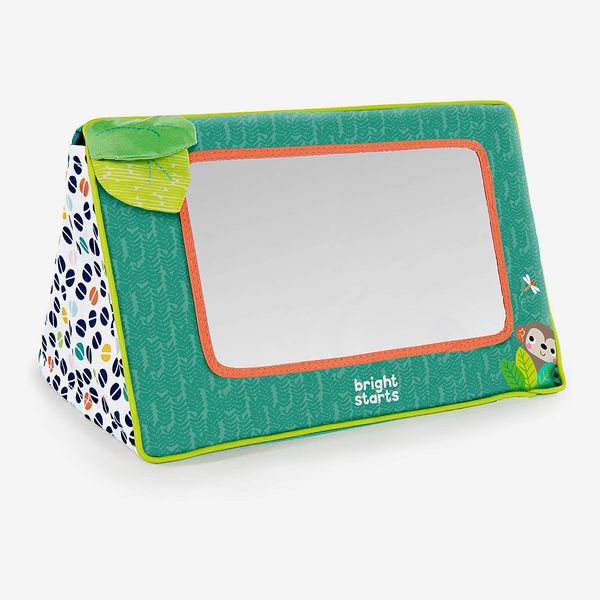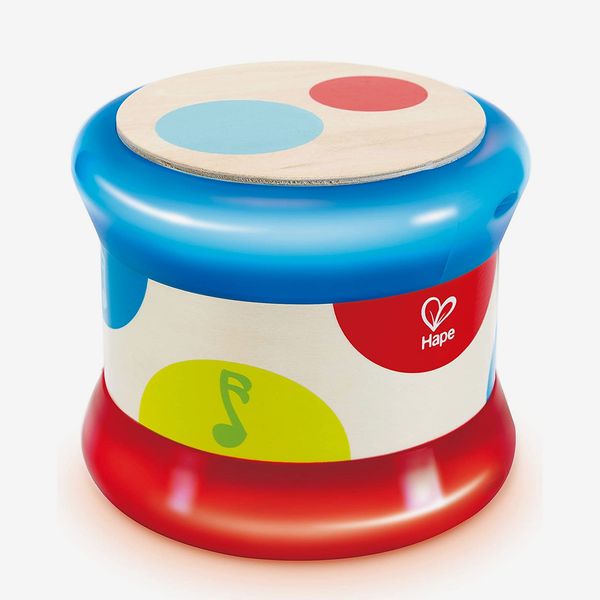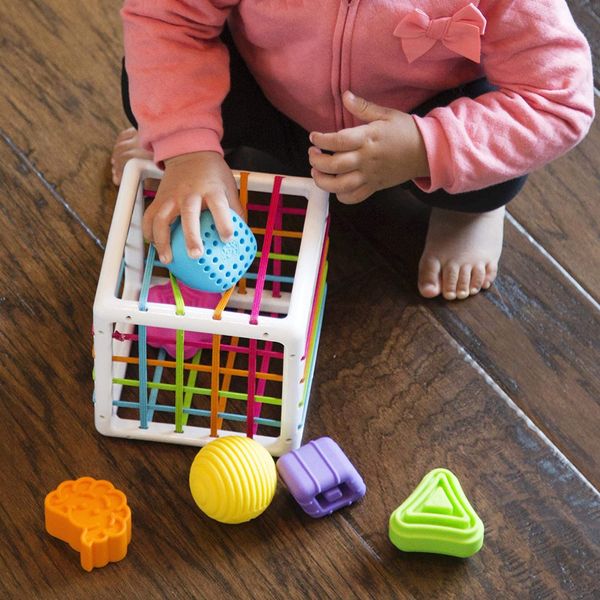
Jump to section
At 6 months old, babies are beginning to feel more and more like little people. They have better control of their bodies as they start to sit up, roll over, and push themselves up with their arms. Their personalities are developing, too, recognizing loved ones and even responding to their names. They’re also wide-eyed at the world around them, grabbing at everything they can get their hands — and mouths — on. (Another exciting milestone is the introduction of solid food.) All of it is extremely fun for everyone involved, and giving them toys that continue to encourage their growth and learning through play will make playtime that much more rewarding.
According to the child-development experts I spoke to for this story, the best gifts are simple ones that encourage sensory exploration, fine and gross motor skills, and cause and effect. Dr. Patricia Cantor, a retired professor of early-childhood education at Plymouth State University and the co-author of Techwise Infant and Toddler Teachers, gave me this easy rule of thumb: “You want to give them a toy they can do something with.” To help you choose the best toys, books, and feeding gear that nurture their development and keep them engaged, I consulted experts as well as parents for their recommendations. And as a mom to a 2.5-year-old and a 5.5-year-old, I’ve included some of my personal favorites, too. Below, the 24 best gifts for 6-month-olds, from books they can eat to a singing crab that motivates crawling. For gift ideas for all ages, check out the Strategist Toy Store, where you’ll find 100 of our favorite tried-and-true toys for all the children in your life, plus age-specific breakdowns here. And for everyone else on your list, head to our holiday gift guide hub.
Update on December 9, 2024: Updated prices and checked stock for all products.
Best gifts for 6-month-olds under $20
Books are always welcome gifts at any age, but three of our experts — Dr. Tovah P. Klein, the director of the Barnard College Center for Toddler Development and author of How Toddlers Thrive; Sarah MacLaughlin, a social worker and the author of What Not to Say: Tools for Talking With Young Children; and Cantor — all cited Baby Faces as their No. 1 recommendation for 6-month-olds. “Babies at this age start to be more inclined to pay attention to a book, and they’re starting to notice other babies’ faces. They really like to look at other babies,” says MacLaughlin. Klein further explains, saying, “The words are not the most important part. Looking at a picture and the interaction with the parent around the book gives the message that looking at books is a positive thing.” Both my kids loved reading this book together, even into their toddler years.
This board book that shows babies from all over the world, from Bhutan to Mali, dressed in traditional garb was also a hit with my boys. It’s a great way to introduce children to different countries.
Alexandra Figueras-Daniel, an assistant research professor at the National Institute for Early Education Research, recommends books from a series called Indestructibles, which are durable books made with a material that’s rip- and waterproof. The books are also very flexible, which she says is great for 6-month-olds because they can actually flip through it and hold it in their hands. (The pages make for an excellent on-the-go teether as well.) This helps them to “learn to turn the pages, and that eventually develops into literacy skills,” which Figueras-Daniel says are important to start encouraging at an early age. Strategist senior writer (and resident toy expert) Liza Corsillo is also a fan: “We had five of these books, and they were always the first thing I packed when we went out to the park or to brunch. My son liked to chew it, fold it, shake it really hard, and even tried to turn the pages. He used it like a noisemaker.”
For an even more interactive book, consider one with sliders, like this book by Camilla Reid that my younger son still reads to this day. Part of the “Peekaboo You” series, it’s beautifully made with cheerful images, and the pull tabs are large enough for small hands (with assistance, of course). It ends with a mirrored page that never fails to delight.
Cantor and Klein recommend lightweight stacking cups to help babies develop their fine motor skills. They’re also a toy that can grow with them. I like this set from Danish company Mushie, which comes in an attractive set of neutral colors and are a little more exciting than those ubiquitous primary-colored ones. The bottoms of half of them have perforated designs, making them great for bath time, too.
For something slightly more challenging, consider this wooden stack-and-sort toy from Fisher-Price that Corsillo recommends. It includes an alligator, lion, and koala that can be mixed and matched into various configurations in a baby version of the Exquisite Corpse game.
A teether, like this bright, nubby silicone pacifier-shaped raspberry, would be a welcoming gift for a baby whose teeth are beginning to come in. Every part of the raspberry, from the leaves to the handle to the fruit itself, is designed to help soothe sore gums.
This teether is a little easier to hang on to, thanks to an interior grip. Strategist senior editor Simone Kitchens got it as a gift when her daughter was 3 months old. “She never took a pacifier (it always popped out), so this was great, especially in the car,” she says. “Now we keep it in the freezer and pull it out when she’s teething.”
Cantor says that a mirror is also great for this age. MacLaughlin notes that a 6-month-old can look at a self-standing mirror like this one during tummy time and also play with it while lying on their stomach. And it’s soft so they won’t hurt themselves on any sharp corners.
Yes, it has lights and plays music and doesn’t necessarily fit into the Montessori philosophy or aesthetic, but it’s such a mesmerizing toy for little ones that you would not want to deprive the baby in your life from its joys. I called it “baby TV” because both my kids would be entranced by it for minutes at a time. Strategist senior editor Winnie Yang says that when her son was 6 months old, he “screeched so hard for it and loved it so much.” It plays ten classic masterpieces, from Chopin to Mozart, while colorful lights flash along to the rhythm of each melody.
At around 6 months, babies are beginning to move around on their own, and Figueras-Daniel says a toy like this beet that plays beatboxing music when it’s rolled is a great way to encourage crawling. When the baby pushes it, the beet’s pointed bottom makes it wobble and rock in an unpredictable path while producing fun beatbox riffs and rattle sounds that, Figueras-Daniel says, entices children to chase after it.
Figueras-Daniel also recommends this wobbly little penguin for experimenting with cause and effect. The toy stands back up after your little one bats at it, while a built-in bell makes a soothing, tinkling sound as it sways from side to side.
Part teether, stuffed animal, and sensory toy, Taggies, which Cantor recommends, can help keep a 6-month-old occupied at home and while on the go, whether in a stroller or on a plane. The soft toy is covered in tags, different textures, crinkly fabric, and a plastic ring, all of which gives your baby plenty to look at.
MacLaughlin explains that brain-building can develop through back-and-forth interactions with caregivers in a process called “serve and return,” and a ball is the perfect toy to encourage that. Rolling the ball, coupled “with lots of eye contact and laughing, is good for their motor skills and social-emotional development as it draws the connection between the child and the adult,” says MacLaughlin. Corsillo bought this ball in a bug print for her baby when he was a 6-month-old because she liked its cute illustrations, size, and classic playground-ball crosshatch texture.
Best gifts for 6-month-olds under $50
Do not underestimate the appeal of a stuffed animal, especially ones from Jellycat. My kids own several versions of this bunny, and they’re all very well loved. They have a nice weight to them, are supersoft, and can withstand a lot of snuggling. They’re stuffies that will last them through their toddler years and beyond.
This light-up drum is the perfect size for helping a little one practice sitting up. Food writer and Eater’s former restaurant editor, Hillary Dixler Canavan, says that her daughter liked leaning forward on it and, of course, banging on it. Canavan especially appreciates the fact that the noises and drum music are actually cute. “I really can’t overstate how rare it is to find noise-making toys that don’t make you want to crawl out of your skin,” she says. “This one — even the drum melodies it plays on its side — is truly tolerable!”
Figueras-Daniel also recommends these stacking blocks that come with little animals. She notes that while they may be a little more challenging for a 6-month-old than the above styles (the manufacturer suggests them for 12-month-olds and up), looking ahead to the next developmental step is important in early-child education. This set encourages fine motor skills and serves a double purpose: stacking blocks and also putting animals inside each box. “The little animals add another level of interest to the game,” she says. Of course, knocking them over is just fine, as that teaches babies cause and effect, according to her.
This motor-skill-honing cube is a more flexible (and therefore perhaps easier) version of rigid shape sorters you’ll see populating toy guides for this age. (Figueras-Daniel calls it “almost like the precursor to a shape sorter.”) Instead of having hard edges, the box’s sides consist of elastic strings in various weave patterns that will challenge a 6-month-old to insert objects without frustrating them. Unlike other shape sorters, babies can reach inside to pull the blocks out, making it much more interactive and rewarding for baby.
For another type of in-and-out toy, Figueras-Daniel also loves this little insect cage that comes with a plushy butterfly, ladybug, caterpillar, and cricket. The compact, eight-inch size and soft handle make it easy to bring along with you.
Sometimes, babies need extra motivation to start crawling, and this roaming crab, which is the newest version of the popular bee toy that I and other Strategist parents swear by, will do just that. Unlike the beet above, this toy lights up and moves around on its own while playing (very cute) music. You can choose between a circular pattern for beginners or a random one to keep them guessing as they master the skill. It also includes a teether and rattle, both of which stack on top of the crab, making it a four-in-one, grow-with-your-child toy.
To accompany the light-up drum, try these little egg-shaped shakers that fit perfectly into baby hands, helping them practice grasping and clutching skills while teaching cause and effect.
Gifts for 6-month-olds under $100
If you’d rather take the guesswork out of gifting age-appropriate toys to the 6-month-old in your life, consider KiwiCo’s Panda Crate, a subscription service that sends out a box of toys tailored to their age every other month. Corsillo likes these boxes because “they are full of things I would be excited to get as a standalone toy,” she says. For example, the “Let’s Listen!” box geared toward 6- and 7-month-olds includes a piano xylophone and shakers for promoting motor skills and introducing sound and movement. Corsillo particularly likes the play scarves and wood scarf keeper, which are a variation on the ubiquitous play-tissue boxes found in other kits. “The keeper looks like a rabbit hutch and has beads you can move along each of the bars, so it incorporates more ways to play,” says Corsillo.
Another milestone for many 6-month-olds is beginning solid foods, an exciting and often nerve-racking event. But getting the right gear, like a high chair and safe, age-appropriate utensils, can make the transition smoother. While silicone feeding tools are the more common choice for babies this age, I prefer using stainless steel as I find the material easier to clean and therefore more hygienic than all the silicone things I’ve tried over the years. (In my experience, silicone holds on to grease, odors, and soap, all of which transfer to the food you put on it.) This set includes a bowl, small cup, and two baby-size spoons for 6-month-olds and up, as well as a larger-sized version for kids 1 year and up. And being made of stainless steel means it’s sturdy and virtually unbreakable. Both my kids love the rainbow finish, too.
If stainless steel feels too hard of a material, consider this set from Miniware that’s made from a plant-based plastic substitute. The nontoxic set includes a bowl and plate, both with silicone suction feet and lids, a cup with lid and straw, and two silicone spoons, and comes in very appealing colors.
The Strategist is designed to surface the most useful, expert recommendations for things to buy across the vast e-commerce landscape. Some of our latest conquests include the best acne treatments, rolling luggage, pillows for side sleepers, natural anxiety remedies, and bath towels. We update links when possible, but note that deals can expire and all prices are subject to change.































